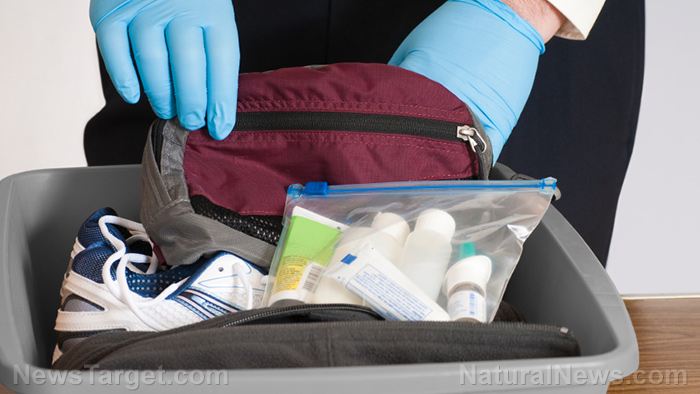Safe flying? Study finds airport security trays carry more viruses than toilets
11/08/2018 / By Tracey Watson

When it comes to surfaces that gross people out, many of us would argue that a toilet seat is the dirtiest, most germ-infested thing out there. While it certainly wouldn’t be wise to view the bathroom as a germ-free zone, in truth there are many other surfaces that are actually dirtier and covered in far more disease-causing viruses than the humble toilet seat.
A recent investigation by researchers from the University of Nottingham and Finland’s National Institute for Health and Welfare uncovered a rather surprising source of germs: The plastic security trays used at the hand luggage x-ray points in airport terminals were found to carry considerably more viruses than the average toilet seat.
Watch out for those trays!
Anyone who has flown anywhere post-911 is familiar with those little plastic trays that airport security officials ask us to dump our keys, purses, laptops and other electronic devices in so that they can be scanned through the x-ray machine for bombs, knives and other potential weapons.
After swabbing various surfaces around the Helsinki airport, the research team found that about 10 percent of surfaces tested were covered in viruses, but that those plastic trays contained by far the most germs.
Other contaminated surfaces included staircase railings, passport control counters, children’s designated play areas and store payment terminals. According to the University of Nottingham, the most commonly detected viruses were the virus that causes the common cold and the influenza A virus. (Related: Grocery carts are germs on wheels.)
Mother Nature's micronutrient secret: Organic Broccoli Sprout Capsules now available, delivering 280mg of high-density nutrition, including the extraordinary "sulforaphane" and "glucosinolate" nutrients found only in cruciferous healing foods. Every lot laboratory tested. See availability here.
The pandemic experts involved in the study noted that with the high number of people passing through airport terminals, basic hygiene protocols like hand-washing and coughing into a sleeve, tissue or handkerchief rather than into the air become even more important than usual.
“People can help to minimise contagion by hygienic hand-washing and coughing into a handkerchief, tissue or sleeve at all times – but especially in public places,” noted Professor of health protection, Jonathan Van Tam. “These simple precautions can help prevent pandemics and are most important in crowded areas like airports that have a high volume of people travelling to and from many different parts of the world.”
Other surfaces that are dirtier than toilet seats
Incredibly, there are actually loads of surfaces that we commonly come into contact with that are covered in far more germs than the toilet seats we all tend to be so wary of. Reader’s Digest reported that there are at least 12 such surfaces, including:
Kitchen cutting boards: A study by researchers from the University of Arizona found that cutting boards contain around 200 times more fecal bacteria than the average toilet seat.
Pet food bowls: While a toilet seat contains around 295 bacteria per square inch, the average pet food bowl is covered in a whopping 2,110 bacteria per square inch!
“Clean” laundry: While toilet seats are too dry to play host to large bacteria populations, the warm, moist environment of the washing machine provides a perfect breeding ground for bacteria like E. coli – 100 million of which can be transferred to your machine from a single load of underwear.
Electronic devices: A study conducted in 2013 in the U.K. found that while the average office toilet seat had less than 20 units per swab of staphylococcus – which causes severe stomach bugs – electronic tablets had around 600 units and smartphones 140 units. With 75 percent of Americans admitting to using their devices while on the toilet, it is unlikely that devices used in the United States are any less germ-infested. (Related: The top places where germs lurk: cell phones, ATMs and more.)
The Reader’s Digest article reveals eight other surprisingly contaminated surfaces and makes for an interesting read.
So, while the toilet seat is certainly not the cleanest surface in the house, it likely isn’t the dirtiest either. When it comes to fighting disease and keeping germs at bay it would probably be good to take a fresh look at all the surfaces in our homes and other environments. It couldn’t do any harm to give the toilet seat an extra clean while we’re at it, though, could it? Learn more about preventing disease at Prevention.news.
Sources include:
Tagged Under: air travel, airport safety, airports, bacteria, commercial flights, dirty surfaces, germs, infectious disease, outbreak, plastic trays, public spaces, surfaces with germs, toilet seats, toilets, Viruses




















